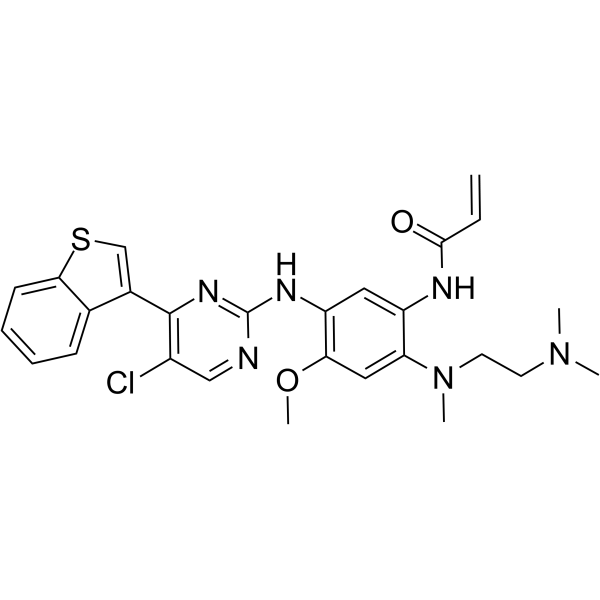上海金畔生物科技有限公司为生命科学和医药研发人员提供生物活性分子抑制剂、激动剂、特异性抑制剂、化合物库、重组蛋白,专注于信号通路和疾病研究领域。
EGFR-IN-44
EGFR-IN-44 (Compound 6a) 是一种有效的、具有口服活性的 EGFR tyrosine kinase 抑制剂,其 IC50 值为 4.11 nM。EGFR-IN-44 诱导细胞凋亡 (apoptosis),口服生物利用度为33.57%。EGFR-IN-44 可以用于非小细胞肺癌的研究。

EGFR-IN-44 Chemical Structure
| 规格 | 是否有货 | ||
|---|---|---|---|
| 100 mg | 询价 | ||
| 250 mg | 询价 | ||
| 500 mg | 询价 |
* Please select Quantity before adding items.
| 生物活性 |
EGFR-IN-44 (Compound 6a) is a potent, orally active EGFR tyrosine kinase inhibitor with an IC50 of 4.11 nM. EGFR-IN-44 induces cell apoptosis and shows an oral bioavailability value of 33.57%. EGFR-IN-44 can be studied for non-small-cell lung cancers[1]. |
IC50 & Target |
IC50: 0.26 nM (EGFR T790M/L858R), 1.33 nM (EGFR L858R), 4.11 nM (EGFR)[1] |
||||||||||||||||||||||||||||||||||||||||||||
|---|---|---|---|---|---|---|---|---|---|---|---|---|---|---|---|---|---|---|---|---|---|---|---|---|---|---|---|---|---|---|---|---|---|---|---|---|---|---|---|---|---|---|---|---|---|---|---|
| 体外研究 (In Vitro) |
EGFR-IN-44 (Compound 6a) (0-10 µM, 72 h) shows anti-proliferative activities against tumor cell lines[1]. Shanghai Jinpan Biotech Co Ltd has not independently confirmed the accuracy of these methods. They are for reference only. Cell Proliferation Assay[1]
Apoptosis Analysis[1]
Western Blot Analysis[1]
Cell Cycle Analysis[1]
Cell Cytotoxicity Assay[1]
|
||||||||||||||||||||||||||||||||||||||||||||||
| 体内研究 (In Vivo) |
EGFR-IN-44 (Compound 6a) (25 mg/kg; i.g.; daily, 7days) shows strong antitumor activity without obvious toxicity[1]. Shanghai Jinpan Biotech Co Ltd has not independently confirmed the accuracy of these methods. They are for reference only.
|
||||||||||||||||||||||||||||||||||||||||||||||
| 分子量 |
537.08 |
||||||||||||||||||||||||||||||||||||||||||||||
| Formula |
C27H29ClN6O2S |
||||||||||||||||||||||||||||||||||||||||||||||
| 运输条件 |
Room temperature in continental US; may vary elsewhere. |
||||||||||||||||||||||||||||||||||||||||||||||
| 储存方式 |
Please store the product under the recommended conditions in the Certificate of Analysis. |
||||||||||||||||||||||||||||||||||||||||||||||
| 参考文献 |
|
所有产品仅用作科学研究或药证申报,我们不为任何个人用途提供产品和服务
